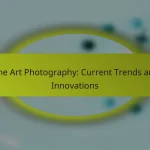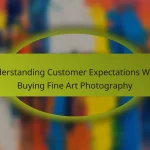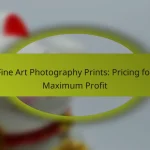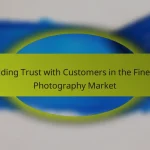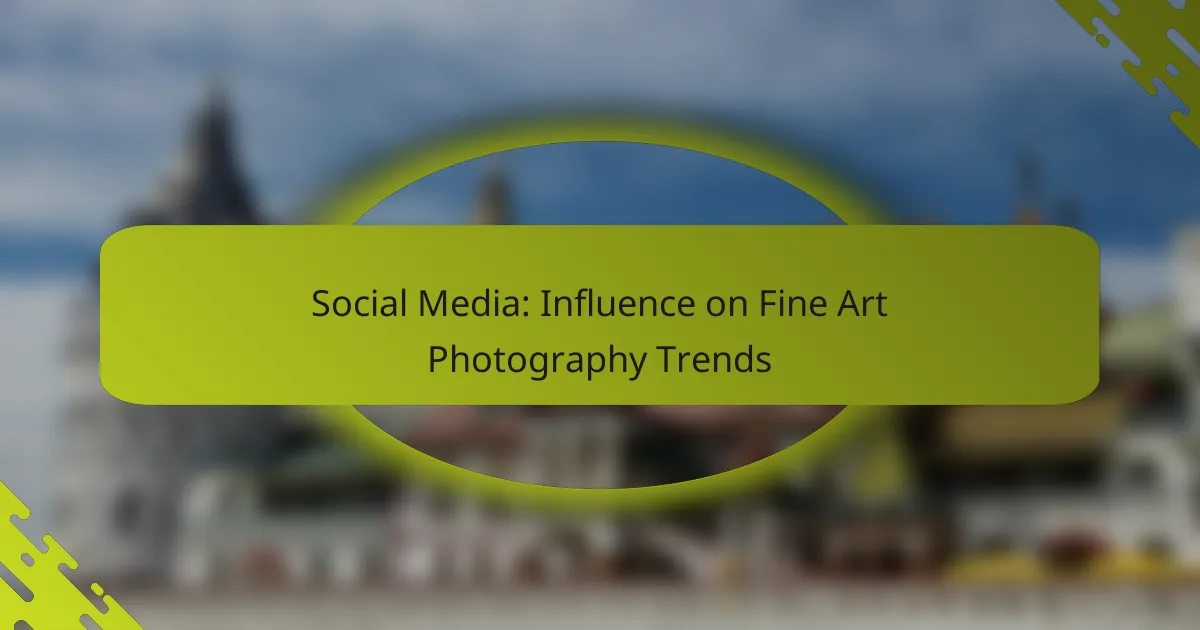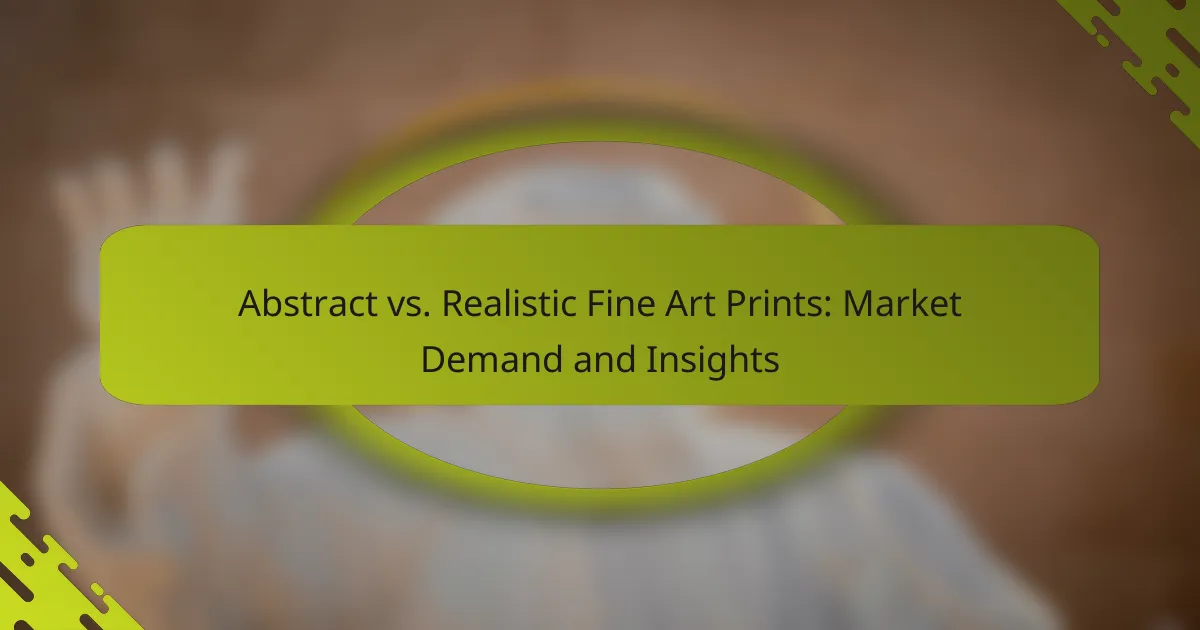Fine art photography is currently experiencing a dynamic evolution, driven by technological advancements and shifting societal values. Artists are embracing innovative techniques that not only enhance their creative expression but also resonate with contemporary audiences, focusing on themes of sustainability and accessibility. As a result, the landscape of fine art photography is being redefined, offering new opportunities for both creators and collectors alike.

What are the current trends in fine art photography?
The current trends in fine art photography reflect a blend of technological advancements and evolving societal values. Artists are increasingly adopting innovative techniques and themes that resonate with contemporary audiences, emphasizing creativity and sustainability.
Digital manipulation techniques
Digital manipulation techniques have become a hallmark of modern fine art photography, allowing artists to enhance their images in ways that were previously unimaginable. Techniques such as compositing, retouching, and the use of advanced software like Adobe Photoshop enable photographers to create surreal and imaginative works that challenge traditional perceptions of reality.
However, it’s essential to maintain a balance between manipulation and authenticity. Over-manipulation can lead to criticism regarding the integrity of the artwork, so artists should consider their audience’s expectations and the message they wish to convey.
Emphasis on sustainability
There is a growing emphasis on sustainability within fine art photography, as artists seek to minimize their environmental impact. This trend includes using eco-friendly materials, such as recycled paper for prints and sustainable inks, as well as adopting practices that reduce waste during the production process.
Additionally, many photographers are exploring themes related to nature and conservation, using their work to raise awareness about environmental issues. This approach not only aligns with global sustainability goals but also resonates with audiences who value eco-conscious art.
Integration of mixed media
The integration of mixed media has gained traction in fine art photography, allowing artists to combine photography with other artistic forms such as painting, sculpture, and digital art. This fusion creates unique, multidimensional pieces that engage viewers on multiple levels.
For instance, photographers might print their images on canvas and then apply paint or other materials to enhance the visual narrative. This approach not only broadens the creative possibilities but also invites viewers to experience art in a more tactile and immersive way.
Rise of social media influence
Social media has significantly influenced fine art photography, providing a platform for artists to showcase their work and connect with a global audience. Platforms like Instagram and Pinterest allow photographers to share their portfolios, gain followers, and even sell their art directly to consumers.
However, the pressure to create content that performs well on social media can sometimes lead to a focus on trends over artistic integrity. Photographers should strive to maintain their unique voice while leveraging these platforms to reach new audiences.
Focus on diverse representation
There is an increasing focus on diverse representation in fine art photography, as artists from various backgrounds seek to tell their stories and challenge dominant narratives. This trend encourages a broader range of perspectives, showcasing the richness of human experience through different cultural lenses.
Photographers are exploring themes related to identity, race, gender, and social issues, which not only enriches the art form but also fosters greater inclusivity within the art community. Engaging with diverse narratives can resonate deeply with audiences and promote dialogue around important societal topics.
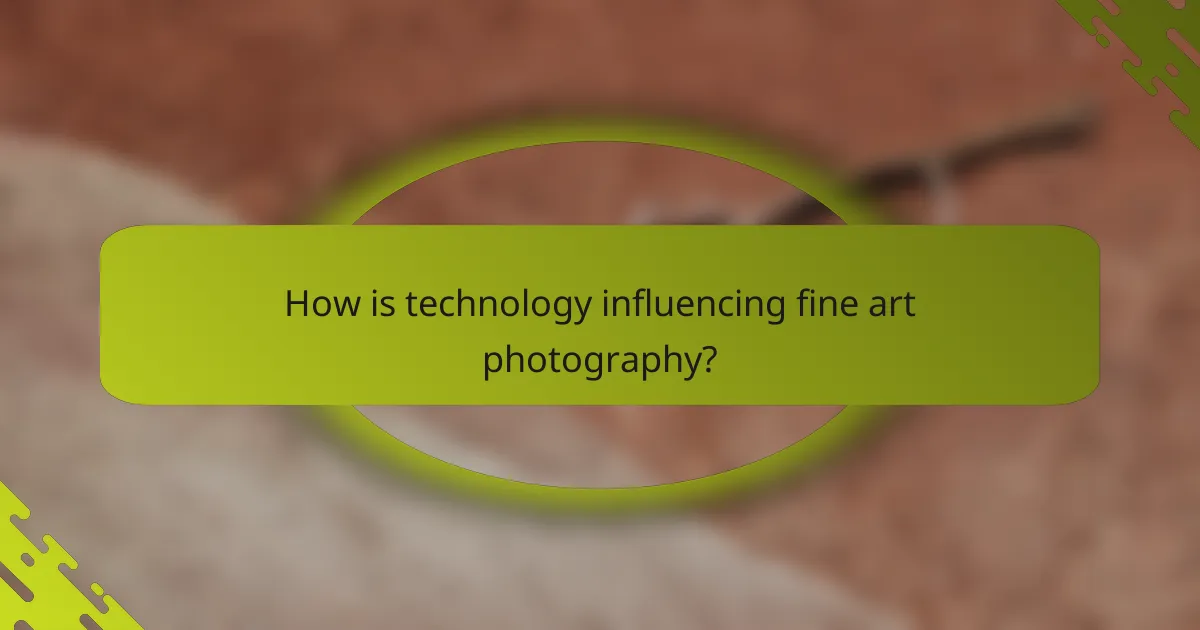
How is technology influencing fine art photography?
Technology is significantly shaping fine art photography by introducing innovative tools and techniques that enhance creativity and accessibility. From advanced imaging devices to immersive experiences, these technological advancements are redefining how artists capture and present their work.
Use of drones for aerial photography
Drones have revolutionized aerial photography by allowing artists to capture stunning perspectives that were previously difficult or impossible to achieve. They provide a unique vantage point, enabling photographers to explore landscapes from above and create dynamic compositions.
When using drones, it’s essential to consider local regulations regarding airspace and privacy. Many countries require permits for commercial drone use, while some areas may have restrictions on where drones can be flown. Familiarizing yourself with these rules can prevent legal issues.
Advancements in camera technology
Recent advancements in camera technology, such as mirrorless systems and high-resolution sensors, have enhanced image quality and versatility for fine art photographers. These cameras often feature faster autofocus, improved low-light performance, and greater dynamic range, allowing for more creative expression.
Artists should explore different camera options based on their specific needs. For instance, a full-frame camera might be ideal for landscape photography, while a compact mirrorless camera could be better suited for street photography due to its portability.
Virtual reality experiences
Virtual reality (VR) is emerging as a powerful medium for fine art photography, enabling viewers to engage with images in immersive ways. Artists can create VR installations that allow audiences to experience their work in a three-dimensional space, enhancing emotional impact and interaction.
To effectively use VR in fine art photography, artists should focus on creating compelling narratives that draw viewers into the experience. Additionally, investing in quality VR equipment and software is crucial for producing high-quality immersive environments that resonate with audiences.
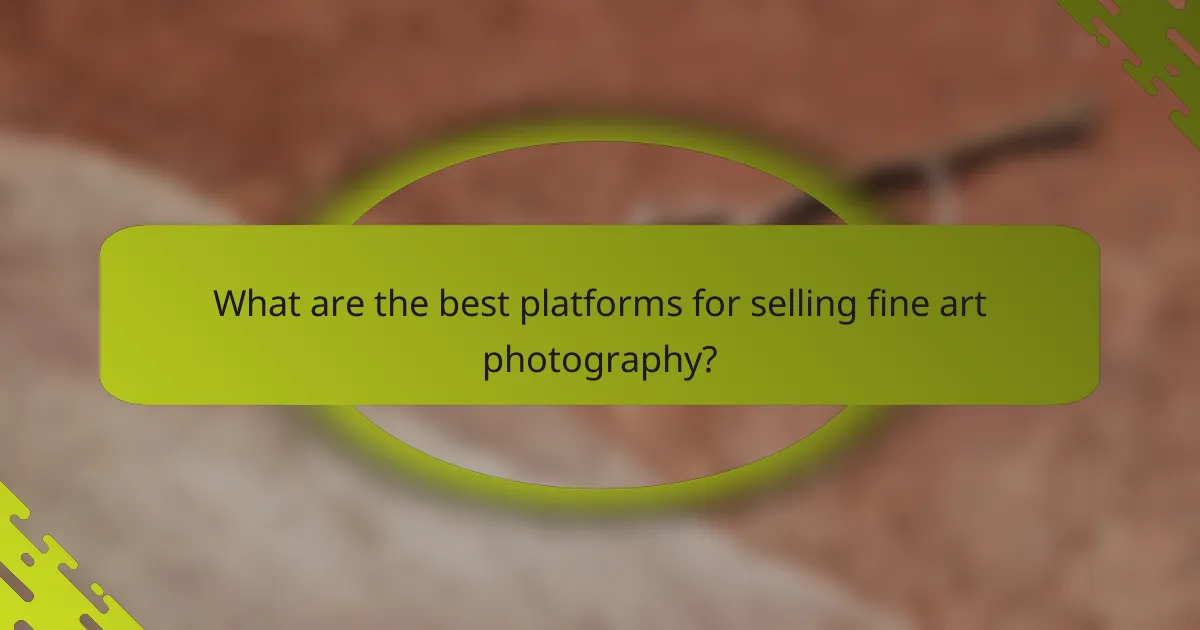
What are the best platforms for selling fine art photography?
The best platforms for selling fine art photography include specialized art marketplaces that cater to both artists and collectors. These platforms provide a range of tools and features to help photographers showcase their work, connect with buyers, and manage sales effectively.
Saatchi Art
Saatchi Art is a well-known online gallery that focuses on original artwork, including fine art photography. Artists can create profiles, upload images, and set prices, while the platform handles shipping and customer service. Saatchi Art takes a commission on sales, typically around 30%, which is a common rate in the industry.
This platform is particularly beneficial for photographers looking to reach a global audience, as it attracts collectors from various countries. Additionally, Saatchi Art offers promotional opportunities, such as featured listings and curated collections, which can enhance visibility.
Artfinder
Artfinder is another popular marketplace dedicated to original art, including photography. Artists can set up their own shops, customize their profiles, and engage directly with buyers. The platform charges a monthly subscription fee along with a commission on sales, which can vary based on the plan chosen.
One of the key advantages of Artfinder is its focus on supporting independent artists, making it a great choice for photographers who want to maintain a personal connection with their audience. The platform also emphasizes sustainability, appealing to environmentally conscious buyers.
Etsy
Etsy is a well-established platform known for handmade and vintage items, but it also serves as a viable option for selling fine art photography. Photographers can create listings for prints or digital downloads, and they have the flexibility to set their own prices. Etsy charges listing fees and takes a percentage of each sale, which can add up depending on volume.
While Etsy offers a vast audience, competition can be high. Photographers should focus on optimizing their listings with strong keywords and high-quality images to stand out. Additionally, utilizing Etsy’s promotional tools can help increase visibility and drive sales.
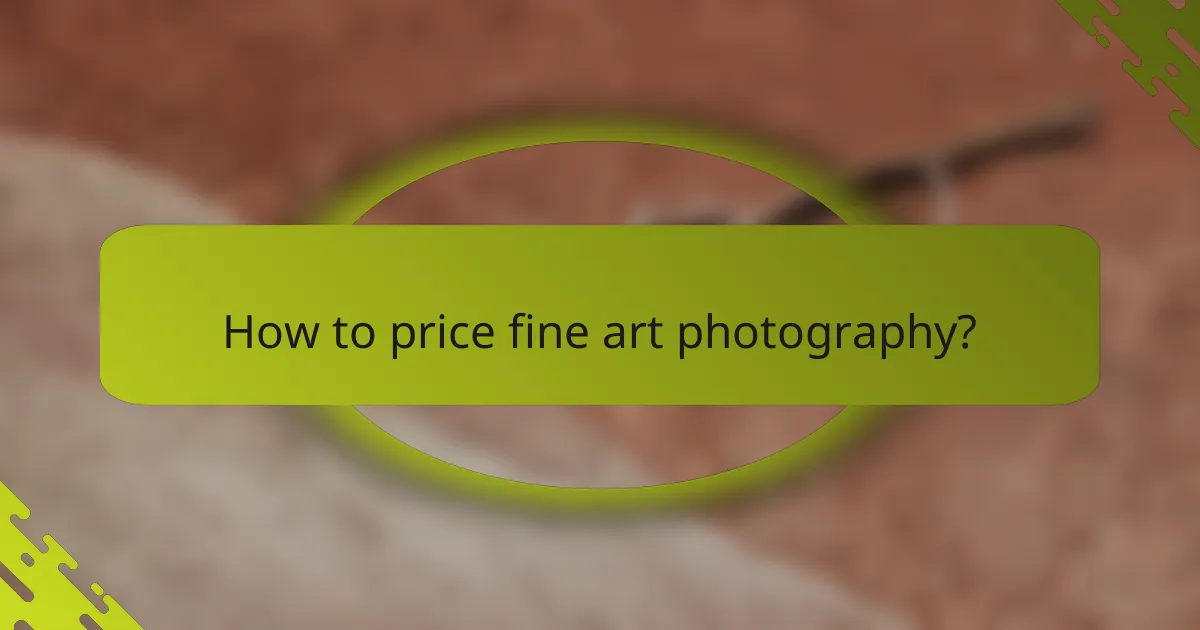
How to price fine art photography?
Pricing fine art photography involves assessing various factors such as the artist’s reputation, the uniqueness of the work, and market demand. A well-researched approach can help photographers set competitive prices that reflect their artistic value and appeal to collectors.
Factors influencing pricing
Several key factors influence the pricing of fine art photography. These include the artist’s experience and recognition, the size and format of the print, and the materials used. Limited editions often command higher prices due to their exclusivity.
Market demand plays a significant role as well; if a particular style or subject is trending, prices may increase accordingly. Additionally, the location of the sale can affect pricing, with urban galleries typically having higher price points than rural settings.
Comparison with traditional art pricing
Fine art photography pricing can differ from traditional art forms like painting or sculpture. While paintings may be priced based on the artist’s history and the medium used, photography often factors in print quality and edition size more prominently. For instance, a limited edition photograph may sell for thousands of dollars, while a similar painting might be priced based on its historical significance.
Moreover, traditional art markets may have established pricing norms, whereas photography is still evolving in terms of valuation. Collectors may be more willing to invest in unique photographic works, especially those that resonate with current cultural trends.
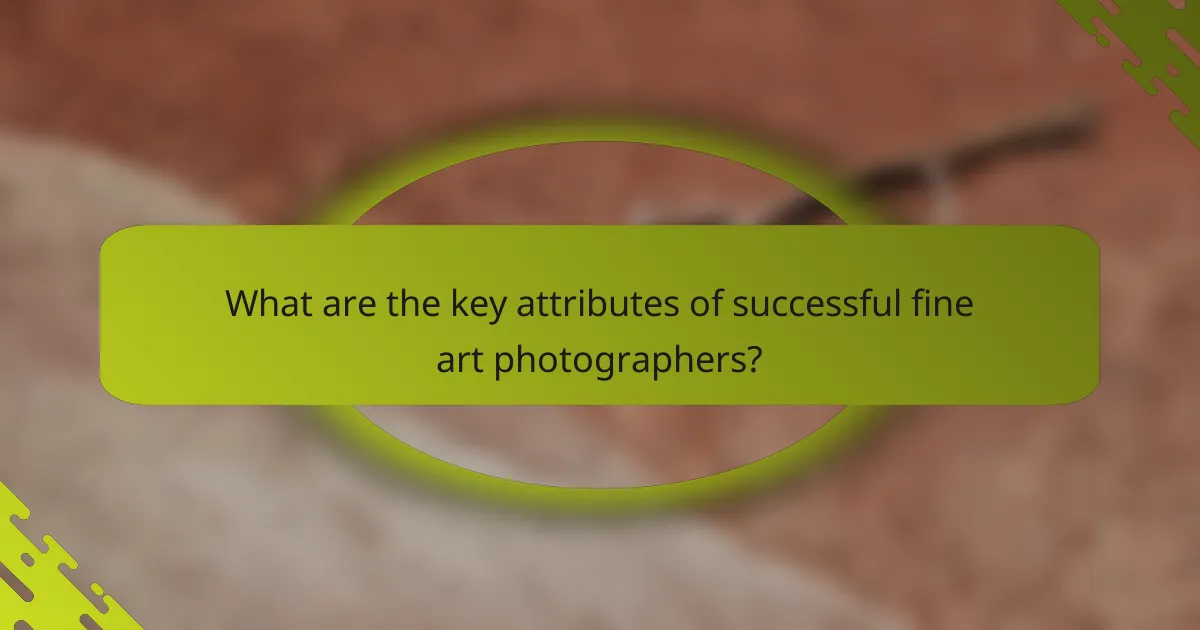
What are the key attributes of successful fine art photographers?
Successful fine art photographers possess a unique blend of creativity, business acumen, and community engagement. These attributes help them not only create compelling artwork but also effectively promote and sell their pieces in a competitive market.
Unique artistic vision
A unique artistic vision is essential for fine art photographers to stand out. This vision encompasses their personal style, themes, and the emotional impact they wish to convey through their work. Photographers should explore various techniques and subjects to develop a distinctive voice that resonates with their audience.
To cultivate this vision, photographers can experiment with different genres, such as abstract, portrait, or landscape photography. They should also seek inspiration from other artists and movements, allowing their creativity to evolve over time.
Strong marketing skills
Strong marketing skills are crucial for fine art photographers to effectively promote their work. This includes understanding how to utilize social media, build a professional website, and engage with potential buyers. Photographers should develop a marketing strategy that highlights their unique artistic vision and connects with their target audience.
Consider using platforms like Instagram and Pinterest to showcase your portfolio and attract followers. Additionally, email newsletters can keep your audience informed about new works, exhibitions, and events, fostering a loyal customer base.
Networking within the art community
Networking within the art community allows fine art photographers to build relationships that can lead to opportunities for collaboration, exhibitions, and sales. Engaging with fellow artists, gallery owners, and collectors can provide valuable insights and support. Photographers should attend art fairs, gallery openings, and workshops to expand their network.
Joining local art organizations or online forums can also facilitate connections. Participating in group exhibitions or collaborative projects can enhance visibility and credibility, ultimately benefiting your artistic career.
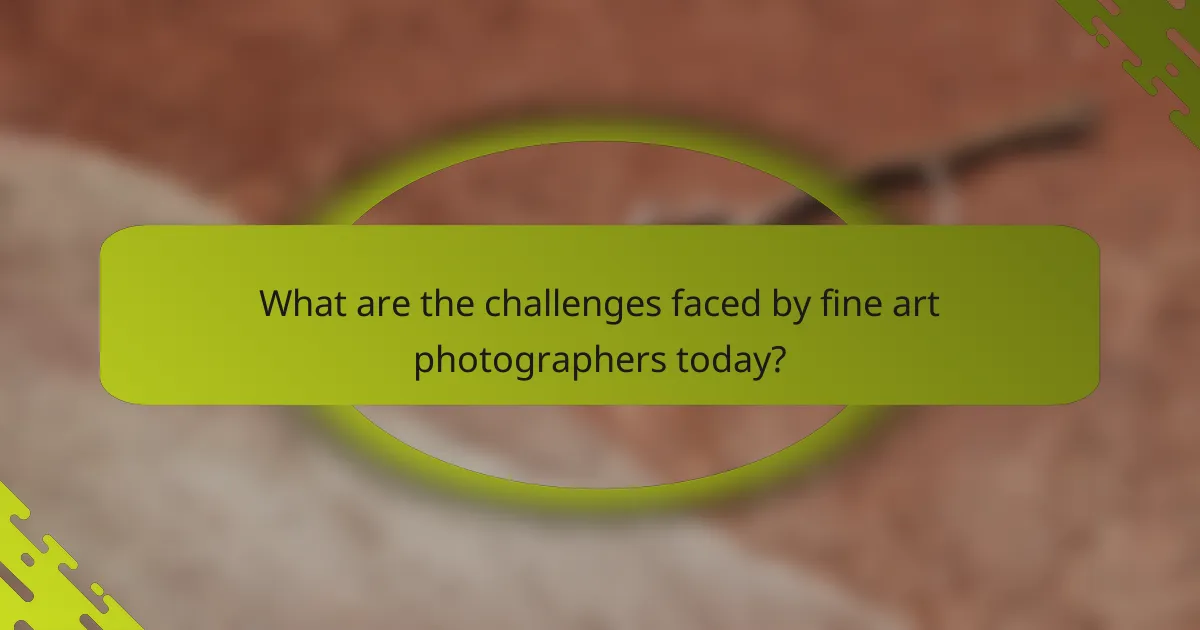
What are the challenges faced by fine art photographers today?
Fine art photographers today encounter several challenges, including market saturation, the impact of digital technology, and the need for effective self-promotion. Navigating these obstacles requires adaptability and a strategic approach to both artistry and business.
Market Saturation
The fine art photography market is increasingly crowded, making it difficult for individual artists to stand out. With countless photographers sharing their work online, developing a unique style and niche is essential. Artists should focus on building a strong personal brand and leveraging social media platforms to showcase their distinctive vision.
Digital Technology Impact
Advancements in digital technology have transformed the way fine art photography is created and consumed. While these tools offer new creative possibilities, they also raise questions about authenticity and value. Photographers must consider how to balance traditional techniques with modern innovations to maintain their artistic integrity.
Self-Promotion and Marketing
Effective self-promotion is crucial for fine art photographers to gain visibility and attract buyers. Many artists struggle with marketing themselves, often feeling uncomfortable with self-promotion. Developing a marketing strategy that includes a professional website, social media presence, and participation in art shows can help photographers reach a wider audience and increase sales.

